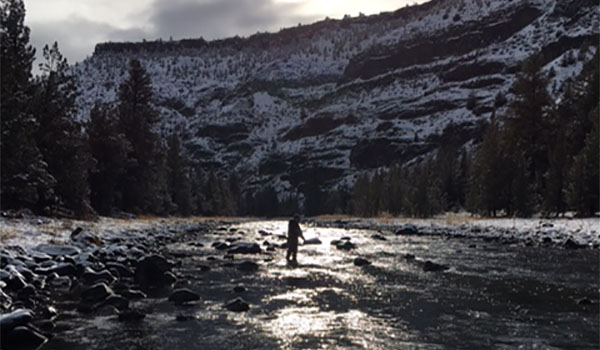Winter fly fishing is here! Oh Yeah! The hours of standing in waist deep 32.1°F water casting a fly line through frozen guides as certain parts of our bodies slowly atrophy in the cold are upon us. Trying to catch fish in the winter as you try to turtle your head into the neck of your jacket as the slightest of breezes pounds frozen daggers into your ears is hard enough. However, freezing my butt off during the short days of winter is my favorite time to be on the water for a multitude of reasons, that is if I catch a trout or two.
Staying somewhat comfortable is important. Wearing a base layer and having some good gloves and a beanie helps obviously.

I won’t go into the common sense methods and gear solutions of staying warm. Y’all are smart enough to figure out what you need to wear to stay warm. After all, that’s the easy part of fishing in the winter. Getting a trout to bite your fly, on the other hand, can be frustrating as heck.
Buckle in and get ready to become enlightened or more enlightened with some techniques and ideas that the crew at Always A Good Day like to use when the snow and rain are pelting us on the stream.
Take The Temperature
Envision this, you are sitting in your living room curled up in a blanket. Your whimpering sobs softly turn into little hoary clouds of falling frost as they leave your mouth. All of this because you spent a night of drunken gear shopping online has left you broke and unable pay your heating bill. Fortunately, you still have a refrigerator full of food but it is so cold you have to be almost starving before you roll out of your cozy quilt to get something to eat. This is how trout feel for about half of the year.
Taking the temperature of the water will let you know, in most cases, where to find fish in the stream or lake. As a rule, fish won’t eat a food source if it doesn’t provide more energy than they expend to eat it. So the cooler the water the less they want to move around to eat something.
The same rule holds when they are just hanging out. A fish doesn’t want to hold in faster water expending energy when it is cold. There is already enough dissolved oxygen in the water

when the water temperature is below 52°F for them to breathe easily. Keeping these two factors in mind will probably lead you to fish slower pools and back eddies. Also, remember that the temperature near the bottom increases as the depth increases due to increased pressure.
More Weight
From what you have read above it is pretty obvious that the fishies are going to probably be holding in deeper water during the winter. This means that heavily weighted flies, sinkers, and heavier sink tip lines all come into play. My rule is if I am not hanging up on the bottom every now, then I am not heavy enough. Having patience with lots of spare flies and tippet are integral when dredging the icy flows in the winter.
Watch and Learn
I say this in everything that I write about being a more successful fly fisherman. In the winter months, this is doubly true. But it isn’t so much about watching for a hatch but studying the water. For instance; I will walk two miles uphill through the snow just to find a run with a heavy seam next to some very soft water.
This type of water sets up perfectly for sluggish trout. There is a relaxing place for the fish to lie while it waits for the current to deliver something to eat, just like the drive-through window at a fast food place. But this is just one example that I have learned from years of getting motion sickness from staring at swirling water. During this cold time of the year reading the water to find fish can be almost as important as choosing the right fly.
If the fish are taking flies from the surface then drawing conclusions about the type of water the fish are in is infinitely easier, obviously. But take a moment to look at the geography of the water surface for just a moment and try to figure out where the fish hold when they aren’t feeding on the surface. You will find that a few minutes of observation will help you figure out where to fish when you can’t see the little rascals.
Go Light
This is so counterintuitive for most anglers in the winter. Many anglers think that the fish are so hungry that they won’t take a second look before they devour your Hare’s Ear or whatever fly you are fishing. This would be true if the trout were in the super swift water, but they usually aren’t when the water is super cold. Your drifts tend to be slower and a slow drift means that the trout has a much longer time to examine the tasty morsel you are offering to them.
If you are fishing subsurface I recommend using fluorocarbon tippets and leaders. Here are a few reasons why:
- Fluoro gives the angler the option of smaller diameter and less light refraction without sacrificing strength.
- The added strength will also help you lose fewer flies when you snag the bottom and lose fewer fish.
- Another impactful reason for using fluorocarbon tippet is there is no elasticity to fluoro. This characteristic drives the point of the hook in a little quicker with less rod movement. On the very subtle takes that tend to happen in the more frigid water, the hook set becomes paramount.
- The last, and my favorite, reason is that it sinks, thus helping my flies get down letting me use less lead or lighter flies.
Using lighter tippet on the surface is almost automatic because of the smaller sized insects that tend to hatch in the colder temps. We all now that the smaller the mono diameter the easier it is to get a drag free drift which is paramount when fishing slowly moving water for sluggish trout. Refusals because of line visibility or the fly dragging go up much more in the winter because of the factors I have stated before.
Remembering that trout aren’t made stupid by the cold like we are in the first step to catching more fish in the wintertime.
Go Small
The insects that hatch tend to be smaller in size to begin with when the snow flies. Winter baetis, tricos, and midges, for the most part, are tiny little cusses to begin with, but for some infinitely frustrating reason trout seem to like the smaller ones. I am not saying to start out with a #3000 Blue Winged Olive if you see what you think is a #20. But if it doesn’t work after a few casts don’t try a new pattern, try a smaller sized one.
Streamer fishing is the same too. Go smaller, deeper and slower. Try presenting the streamer as slowly as possible. Taking smaller strips or feeding some fly line as it swings are as important as size and color. My one favorite technique is to mend downstream and give the fly some line as it swings to slow it down and give the fish a large, side silhouette view of the streamer. This gives the fish’s aggressive feeding instinct time to kick in since the fly is going by slower looking like a more enticing chunk of food.
I have yet to find a place where going smaller doesn’t work in the winter if I am having a hard time hooking up. It took a 5°F day on the Owyhee River 25 years ago to learn this the hard way. I spent two hours fishing to a large Brown trout who was feeding very steadily on the edge of a seam that

peeled off of a rock. Blue wings and midges were hatching steadily that morning and the trout seemed to be eating both. I tried every pattern I had in my box that I thought match the hatch, color, and size. After countless casts and new flies, I finally tied on a #22 Adams. The mayflies that were flying around were #14’s and #16’s, which I had been religiously matching size for size that morning. On my first drift, I hooked the Brown trout. I instantly learned my lesson, one that has been proven to hold true year after year.
Emergers Are Your Friend
The emerging insect is like the middle child of the family. Often overlooked, misunderstood and yet often the most dependable child, this is much like emerger patterns in the winter. Cold fish love eating emerging insects because they can see them easily in the water column and the fish uses much less energy to attack them. This is because the silhouette of the bug is easier to see as it rises and the trout doesn’t have to swim all the way to the surface to eat its lunch.
There are several ways to fish this pattern. You can dead drift it under an indicator, hang it under a dry fly in a dry-and-dropper configuration or swing one. I prefer the old dry and dropper set-up most of the time for a couple of reasons. The first one is that you are fishing the two most visible parts of the water column for fish(most of the time) the middle and surface. The second one is that I feel like I can cover more water because I can dead drift the rig and then swing it at the end of the drift. This makes the emerger pattern look as if it is rising towards the surface. I also suggest using fluorocarbon tippet from the dry fly to the dropper because it does sink and allows for a slower ascent to the surface of the emerger pattern when it is swinging.
The last little hint is to watch the rise forms of the fish if they are coming to the surface. My friend Ryan McCullough wrote a great peace on observing the several different types of rise forms. If you don’t want to go into the minutia of rise forms then remember this rule. If the fish are rising and all you see is dorsal fins and tails it is a fair bet and emerging insect fly pattern will work.
Just Do It!
Fighting frozen fingers and rod guides is no fun. It is more fun than not going out and boo-hooing around the house. Don’t drive your dog, kids or significant other crazy because you haven’t cast a rod in month or two. That is your fault for not taking advantage of fewer anglers and hungry fish in your favorite river or stream. I too am guilty of saying it is too cold or too wet or too whatever to hit the water. But I can honestly say that I have never been unhappy that I bundled up and braved the elements even if I didn’t get a take. Because the coldest, most frozen day of not catching beats the best day ever on the couch.


